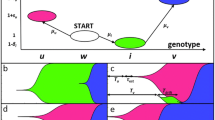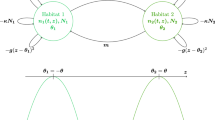Abstract
This paper investigates the problem of how to conceive a robust theory of phenotypic adaptation in non-trivial models of evolutionary biology. A particular effort is made to develop a foundation of this theory in the context ofn-locus population genetics. Therefore, the evolution of phenotypic traits is considered that are coded for by more than one gene. The potential for epistatic gene interactions is not a priori excluded. Furthermore, emphasis is laid on the intricacies of frequency-dependent selection. It is first discussed how strongly the scope for phenotypic adaptation is restricted by the complex nature of ‘reproduction mechanics’ in sexually reproducing diploid populations. This discussion shows that one can easily lose the traces of Darwinsm inn-locus models of population genetics. In order to retrieve these traces, the outline of a new theory is given that I call ‘streetcar theory of evolution’. This theory is based on the same models that geneticists have used in order to demonstrate substantial problems with the ‘adaptationist programme’. However, these models are now analyzed differently by including thoughts about the evolutionary removal of genetic constraints. This requires consideration of a sufficiently wide range of potential mutant alleles and careful examination of what to consider as a stable state of the evolutionary process. A particular notion of stability is introduced in order to describe population states that are phenotypically stable against the effects of all mutant alleles that are to be expected in the long-run. Surprisingly, a long-term stable state can be characterized at the phenotypic level as a fitness maximum, a Nash equilibrium or an ESS. The paper presents these mathematical results and discusses — at unusual length for a mathematical journal — their fundamental role in our current understanding of evolution.
Similar content being viewed by others
References
Dawkins, R. (1976). The selfish gene. Oxford: Oxford Unversity Press
Eshel, I. (1991). Game theory and population dynamics in complex genetical systems: the role of sex in short term and in long term evolution. In: R. Selten (Eds), Game Equilibrium Models I: Evolution and Game Dynamics (pp. 6–28). Berlin: Springer-Verlag
Eshel, I. (1983). Evolutionary and continuous stability. J. Theor. Biol.103, 99–111
Eshel, I. (1995). On the changing concept of population stability as a reflection of changing problematics in the quantitative theory of evolution. J. Math. Biol.34, 485–510.
Eshel, I. and Feldman, M. W. (1984). Initial increase of new mutants and some continuity properties of ESS in two locus systems. Am. Nat.124, 631–640
Ewens, W. J. (1968). A genetic model having complex linkage behavior. Theor. and Appl. Genet.,38, 140–143
Fudenberg, D. and Tirole, J. (1991). Game Theory. Cambridge, Massachusetts: The MIT Press
Gould, S. J. and Lewontin, R. C. (1979). The spandrels of San Marco and the Panglossian paradigm: a critique of the adaptationist programme. Proc. R. Soc. Lond. B,205, 581–598
Hammerstein, P. and Selten, R. (1994). Game theory and evolutionary biology. In: R. J. Aumann and S. Hart (Eds), Handbook of Game Theory with Economic Applications. Volume 2, pp. 929–993. Amsterdam: Elsevier
Harsanyi, J. C. and Selten, R. (1988). A general theory of equilibrium selection in games. Cambridge, Massachusetts: The MIT Press
Karlin, S. (1975). General two-locus selection models: some objectives, results and interpretations, Theor. Pop. Biol.,7, 364–398
Lessard, S. (1984). Evolutionary dynamics in frequency-dependent two phenotype models. Theor. Pop. Biol.25, 210–234
Liberman, U. (1988). External stability and ESS: criteria for initial increase of a new mutant allele. J. Math. Biol.,26, 477–485.
Maynard Smith, J. (1978). Optimisation theory in evolution. Am. Rev. Ecol. Syst.,9, 31–56
Maynard Smith, J. (1982). Evolution and the Theory of Games. Cambridge: Cambridge University Press
Maynard Smith, J. and Price, G. R. (1973). The logic of animal conflict. Nature,246, 15–18
Moran, P. A. P. (1964). On the nonexistence of adaptive topographies. Am. Human Genet.,27, 338–343
Nash, J. F. (1951). Non-cooperative games. Ann. Math.54, 286–295
Tyszka, T. (1983). Contextual multiattribute decision rules. In: L. Sjöberg, T. Tyszka and J. A. Wise (Eds), Human Decision Making (pp. 243–256)
Weissing, F. J. (1995). Genetic versus phenotypic models of selection: can genetics be neglected in a long-term perspective? J. Math. Biol.34, 533–555
Wright, S. (1932). The roles of mutation, inbreeding, crossbreeding, and selection in evolution. Proc. XI. Internat. Congr. Genetics,1, 356–366
Author information
Authors and Affiliations
Rights and permissions
About this article
Cite this article
Hammerstein, P. Darwinian adaptation, population genetics and the streetcar theory of evolution. J. Math. Biology 34, 511–532 (1996). https://doi.org/10.1007/BF02409748
Received:
Revised:
Issue Date:
DOI: https://doi.org/10.1007/BF02409748




